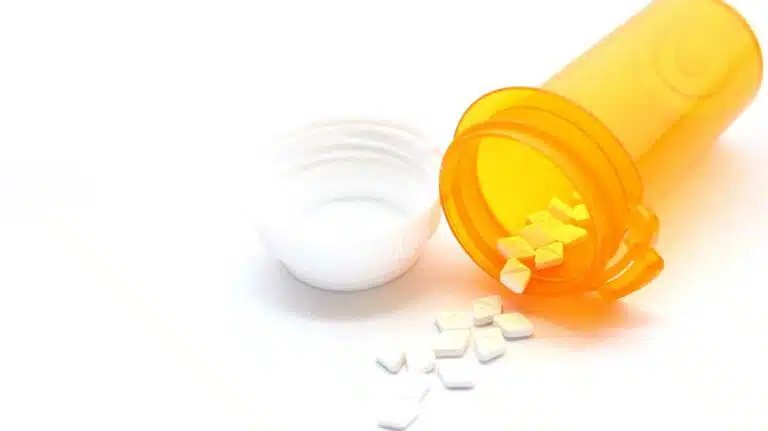Lucemyra Dosage & Prescription Info
- Lucemyra Dosage
- Prescription Info
- Risks
- Other Medications For Opioid Withdrawal
- Is Lucemyra Right For You?

Lucemyra (lofexidine) is a non-opioid used for relief of opioid withdrawal symptoms. You can use it for up to 14 days after you stop taking opioids. A typical dose is three 0.18 mg tablets taken four times a day. Medical conditions and other drugs may affect your dosage.
Lucemyra (lofexidine) is a non-opioid drug that eases opioid withdrawal. It’s a central alpha-2 receptor adrenergic agonist, which means it relaxes your blood vessels to produce better blood flow, lower blood pressure, and pain relief.
Opioids cause physical dependence. If you suddenly stop taking an opioid, you’re likely to have an adverse physical reaction as your body adjusts. The opioid discontinuation process can be unpleasant and lead to relapse or further drug use.
Lucemyra can reduce opioid withdrawal symptoms like muscle cramps, nausea, and insomnia, making it easier to stop using opioids and avoid long-term addiction.
Lucemyra Dosage
A typical starting dosage of Lucemyra is three 0.18 mg tablets taken four times per day. Each dose should be five or six hours apart.
People with hepatic impairment (liver) or renal impairment (kidneys) may be given a lower dose.
Lofexidine is a short-term drug that should only be used for up to 14 days. If you take it, be sure to follow your doctor’s medical advice and prescription guidelines.
Lucemyra Prescription Info
You may have adverse effects while taking Lucemyra (lofexidine). Side effects tend to be dose-dependent (serious side effects show up more at higher doses).
Lucemyra side effects include:
- difficulty sleeping (insomnia)
- dizziness or lightheadedness
- fainting
- drowsiness
- sedation
- dry mouth
- low blood pressure (hypotension)
- low heart rate (bradycardia)
- ringing in the ears (tinnitus)
Lucemyra Drug Interactions
Lucemyra can interfere with the function of other drugs. Drug interactions with Lucemyra include the following:
- Central nervous system depressants: These drugs slow down your breathing and heart rate, causing relaxation and sedation. Taking them with Lucemyra can intensify their effects to unsafe levels.
- CYP2D6 inhibitors: Some drugs, like the antidepressant paroxetine, inhibit an enzyme that’s essential for the metabolism of other drugs. CYP2D6 inhibitors can increase the levels of Lucemyra in your body.
- Methadone: Lucemyra and methadone increase the time it takes for the heart muscle to contract and release (the QT interval). Taking them together increases the risk of QT prolongation, which can cause a dangerous heart condition.
- Oral naltrexone: Naltrexone reduces opioid cravings by blocking the effects of opioids. Taking Lucemyra with it makes the naltrexone less effective.
Let your doctor know if you’re taking supplements or other medications, as they may alter the effectiveness of Lucemyra.
Risks Of Taking Lucemyra
The research on Lucemyra is limited for certain populations, including pregnant and breastfeeding women, children and adolescents, and people over 65. However, there are several known risks to the general population.
Taking Lucemyra gives you an increased risk of:
- Long QT syndrome: a condition in which the heart takes too long to contract and release, lowering the amount of oxygen pumped through the body.
- Orthostatic hypotension: low blood pressure when standing after sitting for a while, decreasing how much oxygen gets to vital organs, like the brain.
- Bradycardia: low heart rate, which also lowers oxygen levels.
- Syncope: loss of consciousness that occurs when the brain doesn’t get enough oxygen.
- Worsened withdrawal symptoms: more severe withdrawal symptoms than with other opioid medications, but the withdrawal process may be shorter.
- Complications with other depressants: central nervous system depressants like alcohol, opioids, or benzodiazepines can intensify sedation and cause dangerous respiratory depression when combined with Lucemyra.
- Opioid overdose: resuming opioid use at your former dosage after taking Lucemyra can cause an overdose.
When you stop taking Lucemyra, your body may have adverse reactions or withdrawal symptoms such as:
- a spike in blood pressure
- pain in the extremities
- excessive sweating (hyperhidrosis)
- chills
- diarrhea
- insomnia
- anxiety
Other Medications For Opioid Withdrawal
Lucemyra is unique because it isn’t an opioid, and you don’t have to detox before taking it. The idea is that you can stop taking opioids completely and take Lucemyra instead. The withdrawal process should be easier to bear, making it possible to get off opioids even if you’re addicted.
Other medications for opiate withdrawal work differently but can still be effective.
Methadone
Methadone is an opioid that’s not nearly as potent as heroin or prescription painkillers. It’s a long-acting opioid agonist—it activates opioid receptors but blunts or blocks the effects of other opioids. These effects reduce opioid cravings and withdrawal symptoms.
Methadone maintenance typically lasts at least 12 months and may continue indefinitely.
Buprenorphine
Buprenorphine (Subutex, Suboxone) is a mild opioid that partially activates opioid receptors. It produces euphoria and respiratory depression like other opioids but has much weaker effects if you take the proper dosage.
Because of its sedative effects, buprenorphine is often combined with naloxone (an opioid overdose reversal agent) to reduce the likelihood of abuse.
You start taking buprenorphine 12 to 24 hours after stopping opioids. As your recovery progresses, you may be able to get a dose adjustment from a daily dose to an alternate-day dose. You can use it as long as your healthcare provider deems it necessary for your recovery.
Naltrexone
Naltrexone is a non-addictive non-opioid drug. It blocks the euphoric and sedative effects of opioids by binding to and blocking opioid receptors. This reduces opioid cravings.
You can get oral naltrexone (Revia) or a monthly injection (Vivitrol). Only Vivitrol is FDA-approved for opioid addiction.
The hard part about naltrexone is you have to wait at least seven days after stopping a short-acting opioid and 10 to 14 days after a long-acting opioid before taking it.
Lucemyra is a possible solution to this problem. Some people can take Lucemyra for the first couple of weeks of withdrawal to make opioid detox bearable. Then they switch to naltrexone, a longer-term treatment.
Is Lucemyra Right For You?
Only you and a qualified healthcare professional can determine if Lucemyra is right for you. If you or a loved one are struggling with opioid use disorder, reach out to a specialist who can help you create an appropriate treatment plan.
At Ark Behavioral Health, we offer comprehensive rehab programs for opioid dependence that are tailored to your needs. Contact us today to learn more.
Written by Ark Behavioral Health Editorial Team
©2024 Ark National Holdings, LLC. | All Rights Reserved.
This page does not provide medical advice.
Harvard Health Publishing - Lofexidine: Another option for withdrawal from opioids, but is it better?
National Library of Medicine: DailyMed - lofexidine hydrochloride tablet, film coated
National Library of Medicine: MedlinePlus - Lofexidine
Substance Abuse and Mental Health Services Administration - Buprenorphine
Substance Abuse and Mental Health Services Administration - Methadone
Substance Abuse and Mental Health Services Administration - Naltrexone
Questions About Treatment?
Ark Behavioral Health offers 100% confidential substance abuse assessment and treatment placement tailored to your individual needs. Achieve long-term recovery.
100% confidential. We respect your privacy.
Prefer Texting?
Our friendly support team is here to chat 24/7. Opt out any time.







 Learn More
Learn More








